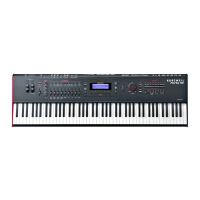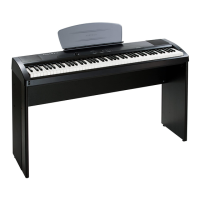15-12
Advanced KDFX
Effects Buses
for example, if youÕve combined several inputs into one FXBus and the signal is too hot for the
FX preset, you can pad it down here. The Trim is adjustable from Off/-79.0 dB to +24 dB.
Below the Input Gain is usually (but not always) an Output Gain, which sets the level of the
signal leaving the FX preset, which can be further modiÞed by the Mix and Aux sends on the
FXBUS page.
The other parameters that appear on this page are determined by the algorithm. Each algorithm
has its own set of parameters, which may take up as many as four pages, accessed using the soft
buttons PARAM2, PARAM3, etc. The parameters associated with each algorithm are discussed
in detail beginning on page 15-35, and at the beginning of Chapter 10 of the MusicianÕs Reference.
When you change a parameter on one of these pages, you have changed the FX preset, and if
you want the change to be permanent, you must save the FX preset. Pressing either of the
<more> soft buttons accesses Name, Save, Delete, and Dump pages for the FX preset. FX presets
are stored in RAM, just like K2600 keymaps. When an FX preset is recalled, either by itself (from
within the Studio Editor) or as part of a studio, its associated algorithm and all parameters are
recalled with it.
There is another way to edit an FX presetÕs parameters without altering the FX preset itself, and
that is by using bus overrides.
Bus Overrides (Bus Mods)
We havenÕt yet talked about the two parameters that are on the Insert FXBUS and AUXFX pages,
directly underneath the name of the FX preset. These are called Òbus overridesÓ or Òbus mods,Ó
and they allow you to change parameters within an FX preset without actually going into the
FX preset.
Wet/Dry||||:35%
Out|Gain|||:2.0dB
For example, the bus overrides on FX1 are often Wet/Dry mix and Output gain. Normally, these
parameters would be found inside the FX preset, and if you changed them, youÕd have to save
the new FX preset in order to keep the changes.
Instead, using bus overrides, you can adjust these two parameters and hear what they sound
like while you are adjusting them without going into the FX preset. When you save the studio,
these parameter values are saved, but they are not part of the FX presetÑthey are part of the
studio. Therefore, the FX preset remains unchanged (and if the FX preset is in use elsewhere, it
hasnÕt changed there), but these two parameters in this particular FXBus have been altered.
Wet/Dry and Out Gain are the default bus overrides you will encounter most often, but in some
algorithms and FX presets, other parameters are accessed as bus overrides. For example, on
some compressor algorithms, the Þrst bus override is an In/Out switch; and on some dual-
channel delay and Þlter algorithms, the overrides are separate Wet/Dry controls for the left and
right channels.
Making and Breaking Bus Overrides
Some studios supplied with KDFX, when you Þrst encounter them, have the bus mods in place,
but they are not engagedÑthat is, theyÕre not actually overriding anything, but instead simply
show the values of the corresponding parameters inside the FX preset unchanged. To see this,
choose an FX preset on the FXBUS page and look at the values of the override parameters, Wet/
Dry and Out Gain. Now go inside the FX preset by highlighting the FX presetÕs name and

